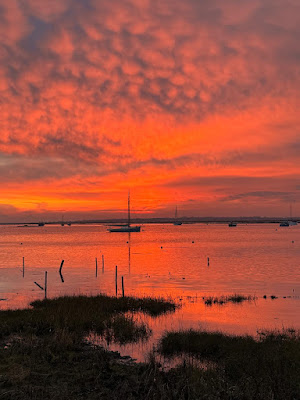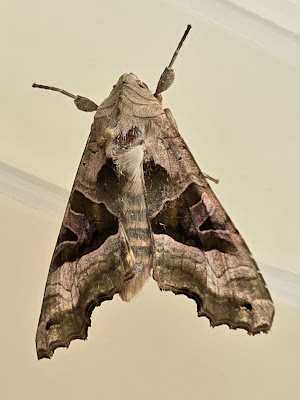A perfect winter's morning on Sunday 12th with an overnight frost giving way to blue skies and a hint of warmth in the sunshine. There were calm conditions along the Strood channel and lots of waders and wildfowl to be seen, like this pair of
shelduck.
Five
ringed plovers were feeding on the mud close to the Strood seawall on Sunday. Other waders noted were 250
knot, 200
dunlin, 40
oystercatchers, 30
avocets and four
snipe in the fields.
A few
turnstones were also along the Strood channel on Sunday.
The male
kestrel was on top of his usual willow tree along the Strood seawall on Sunday. Three
marsh harriers also noted. Three
stonechats, two
Cetti's warblers heard calling were noted, while by the Firs caravan park were a
mistle thrush, song thrush and twenty
goldfinches.
In Firs Chase a male and female blackcap visited the garden feeders and a red squirrel was seen on Sunday too.
At East Mersea Point birds seen by Jonathan Norgate on Sunday morning were the purple sandpiper, five skylarks, three red-breasted mergansers and two distant eiders in the Colne. Also two rock pipits and 28 meadow pipits by the Golfhouse.
On a very misty Saturday 11th, the
purple sandpiper eventually turned up at the Point about an hour after the high tide, allowing Andy Field to take this photograph. Also noted at Cudmore Grove were 50
turnstones, 15
sanderling, buzzard in the kestrel tree, a few
meadow pipits and a
rock pipit in the grazing fields. There was an unconfirmed report of the
shorelark at the Point for Saturday.
In Shop Lane late afternoon on Saturday a tawny owl and two goldcrests were seen by Steve Entwistle, while a green woodpecker and stock dove were by the East Mersea Golfhouse.
Very little was seen through the thick mist on Saturday morning at Maydays with a quick walk in the freezing conditions revealing only a marsh harrier, 18 golden plovers, 3 avocets, fieldfare and a rock pipit.
The regular female
blackcap was back at the feeders in the Firs Chase garden again on Saturday.
A
mistle thrush was feeding in the mistletoe clumps in the poplar trees at the Firs Chase caravan park on Friday 10th. Birds noted in a brief visit to the Strood seawall included a
sparrowhawk, buzzard, kestrel,
grey heron, little egret, Cetti's warbler, two
ringed plovers, 12
curlew in the field and ten
little grebes in the channel.
A great white egret was seen at Maydays farm on Friday by Martin Cock.
A female
kingfisher was back at its favourite spot along the Strood dyke at the south-west end on Thursday 9th. The other birding highlight was seeing two
hen harriers at the same time hunting opposite ends of Ray Island. A ringtail
hen harrier had been flying over the Peldon seawall before crossing onto Ray Island, while a male
hen harrier flew low over the Ray saltmarsh towards Bonners Barn. Its been several years since I've watched two hen harriers at the same time here!
Two marsh harriers were also seen flying over the fields and the Strood channel.
Two
song thrushes were feeding along the Strood seawall on Thursday. A
mistle thrush was by the Firs Caravan park poplar trees. Two
stonechats, corn bunting and a
Cetti's warbler also noted.
Forty-four
avocets were along the Strood on Thursday, a few seen here with some
wigeon and
teal. Good numbers of duck along the channel were 300
teal, 100
wigeon and 80
shelduck, with 15
little grebes also seen too. A flock of about thousand
brent geese rose into the air off Feldy Marsh with some dropping down into the Ray Channel.
A male
shoveler was resting with the other ducks on the Strood channel on Thursday.
A female blackcap was in the Firs Chase garden on Thursday.
On Wednesday 8th at Maydays, Martin Cock reported a greenshank, two pintail, corn bunting, rock pipit, two marsh harriers and ten fieldfares. Later at West Mersea Hard a kingfisher was seen sitting at the end of the hammerhead pier seen by Martin.
Along the Strood channel on Tuesday 7th were lots of waders and wildfowl on show, such as this small group of
wigeon with
teal and a
black-tailed godwit. The ducks on show in the channel included 140
shelduck, 200
teal and 100
wigeon, with 46
oystercatchers, 44
avocets and 200
knot.
A marsh harrier was hunting the Strood fields on Tuesday, three stonechats, ten corn buntings, ten meadow pipits and a rock pipit were seen during the walk along the seawall. A mistle thrush was by the caravan park.
At East Mersea there was no sign on Tuesday of the shorelark or snow bunting despite looking by Andy Field, although two chiffchaffs were seen feeding in the leaf litter at Cudmore Grove, while a fieldfare was by the East Mersea road.
There was an unconfirmed report of a Caspian gull and water pipit reported from Cudmore Grove on eBirds for Tuesday.
At West Mersea three great northern divers were seen offshore from the Esplanade by Steve Entwistle on Tuesday. Michael Thorley saw three Mediterranean gulls at Kingsland Beach in the morning.
The Strood
snow bunting was very obliging and showy on Monday 6th as it fed along the side of the seawall.
This winter male
snow bunting has been here for five days now, although not restricted to one regular spot. The last Strood
snow bunting was one photographed by Andy Neal on 8th November 2015.
Other birds noted on Monday along the Strood seawall were 300 teal, 100 wigeon, 200 knot, 25 avocets, while in the fields were 200 rooks, 200 jackdaws, a buzzard and there was a song thrush in Feldy View.
Weather was a bit miserable on Sunday 5th, so the only photograph taken of the Strood
snow bunting was this phone-pic. The
snow bunting wasn't spotted on the walk along the seawall to start with, but on the return it was discovered crouching down between the concrete blocks on the seawall side.
Three Egyptian geese flew past Feldy View towards the Strood channel on Sunday. Other birds noted were a kingfisher perched along the Strood dyke, two marsh harriers, buzzard, sparrowhawk, 100 knot, stonechat, Cetti's warbler and also a mistle thrush by the Firs Chase caravan park.
A
redwing was seen by Shaun Bater in his West Mersea garden on Sunday.




















































